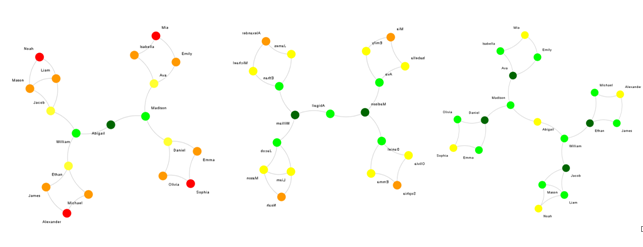How to Keep Your Company Happy and Healthy?

Ein Artikel von Dr. Christian Michael Schneider, ehemaliger Mitarbeiter DYMATRIX
Network Theory and its Business Implication – Part 4
This post focus on the key resource of a company, its employees and their social relationships.
Employees, who are happy and healthy, are far more productive and have a lower termination rate, however, the employee satisfaction is facing diverse risks ranging from (extreme) sports over illnesses to unfriendly colleagues. While a company is neither in charge nor allowed to control and change most of the behavior, nevertheless the working atmosphere within the company can be improved. There are many ways to enhance the working atmosphere, for example with team-events like whitewater kayaking or barbecue party. These events are hard to describe from the network theoretical point of view, but the daily social interactions of the employees can be used.
A typical example is the spread of rumors. As a director one would like to know whom to ask to get the latest rumors or whom to chat to informally update the employees. The answers to these questions can be mapped on a network theory problem, namely the immunization problem in network theory. This problem is described as follows: Which nodes (employees) should be immunized (asked) to avoid disease spreading (get the latest rumors)?
While the initial question is quite simple, the answer is not. The answer depends on number of nodes one can immunize, size and properties of the network as well as on spreading and immunization processes itself [1-3] and an optimal solution cannot be guaranteed. Here we focus on one specific case, namely which are the nodes one should immunize, if the number of immunized nodes is fixed. The problem is known as the graph partitioning problem [4], illustrated in the following figure:

To divide this network into two small parts, it is best to immunize Abigail. However, if one can immunize two people, William and Madison is the best choice and for four people Jacob, Ethan, Ava and Olivia. Here one can easily see that the optimal solution for a particular number of immunized people is not the subset of the optimal solution for immunizing more people.
Back to the original business questions, if this network would be the social network of a company (though both the communication level as well as the gender mixture is quite bad), one has to talk to one/two/four persons to get the latest rumors before ten/five/four people already got it. Also in case of the propagation of information the same people play a key role as show in the following figures:

The colors correspond to the propagation path of the information (dark green – first; red – last). Now our director just have to decide how soon he likes to get the latest rumors.
This small example shows how propagation phenomena can be described and analyzed with network theory to improve operational processes in a company. Note that this kind of technique can also be used for supply chain analysis and risk analysis.
The next blog is about getting customer networks to apply network techniques.
Part 0. Network Theory and its Business Implication
Part 1. Identifying relevant business networks
Part 2. Is your customer or your customers’ friend more important for your business?
Part 3. How to identify product groups?
Part 4. How to keep your company happy and health?
Part 5. How to get customer (friendship) networks?
Part 6. Affinity modelling with network properties
[1] Finding and evaluating community structure in networks, MEJ Newman et al. – Physical Review E 69 (2), 026113, 2004
[2] Suppressing epidemics with a limited amount of immunization units, CM Schneider et al. – Physical Review E 84 (6), 2011
[3] Inverse targeting – An effective immunization strategy, CM Schneider et al. – Europhysics Letters 98 (4), 46002, 2012
[4] Finding a better immunization strategy, Y Chen et al. – Physical review letters, 2008



